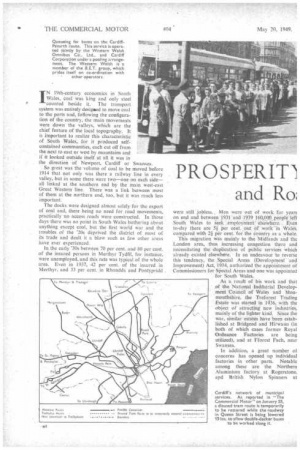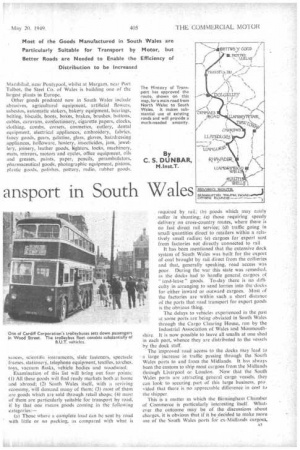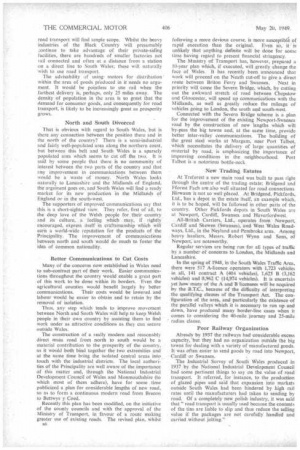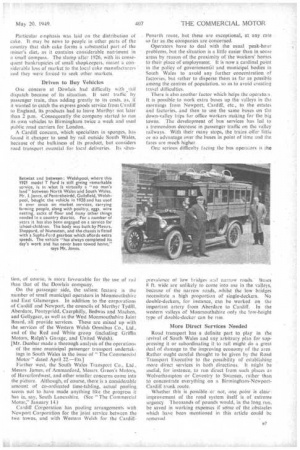PROSPERM and Ra, ansport in South Wales
Page 10

Page 11

Page 12

Page 13

If you've noticed an error in this article please click here to report it so we can fix it.
By C. S. DUNBAR, m.Inst.T.
N 19th-century economics in South Wales, coal was king and only steel • counted beside it, The transport system was entirely designed to move coal to the ports and, following the configuration of the country, the main movements were down the valleys, which are the chief feature of the local topography. It is important to realize this characteristic of South Wales, for it produced selfcontained communities, each cut off from the next to east or west by mountains and • if it looked outside itself at all it was in the direction of Newport, Cardiff or Swansea. So great was the volume of coal to be moved before 1914 that not only was there a railway line in every valley, but in some there were two—one on each side— all linked at the southern end by the main west-east Great Western line. There was a link between most • of them at the northern end, too, but it was much less important.
The docks. were designed almost solely for the export of coal and, there being no need for road movements, practically no access roads were constructed. In those days there was no point in South Wales bothering about anything except coal, but the first world war and the troubles of the '20s deprived the district of most of its trade and -dealt it a blow such as few other areas have ever experienced.
In the early '30s between 70 per cent. and 80 per cent. of the insured persons in Merthyr Tydfil, for instance, were unemployed, and this rate was typical of the whole area. Even in 1937, 42 per cent. of the insured in Merthyr, and 33 per cent. in Rhondda and Pontypridd were still jobless.. Men were out of work for years on end and between 1911 and 1939 160,000 people left South Wales to seek employment elsewhere. Even to day there are Si per cent out of work in VVales, compared with 2 per cent. for the country as a whole.
This migration was mainly to the Midlands and the London area, thus increasing congestion there and necessitating the duplication of public services which already existed elsewhere.. In an endeavour to reverse this tendency, the Special Areas (Development and Improvement) Act, 1934, authorized the appointment of Commissioners for Special Areas and one was appointed for South Wales.
As a result of his work and that of the National InthIstrial Development Council of Wales and Monmouthshire. the Trcforest Trading Estate was started in 036, with the object of attracting new industries, mainly of the lighter kind. Since the war, similar estates have been established at Bridgend and Hirwatin (in both of which cases former Royal Ordnance Factories are being utilized), and at Fforest Each, near Swansea.
In addition, a great number of concerns has opened up individual factories in other parts. Notable among these are the Northern Aluminium factory. at Rogerstone, and British Nylon Spinners at Ntlainhilad, near Pontypool, whilst at Margam, near Port Talbot, the Steel Co. of Wales is building one of the largest plants in Europe.
Other goods produced now in South Wales include abrasives, agricultural equipment, artificial flowers, asbestos, automatic stokers, bakery equipment, bearings, belting, biscuits, boots, boxes, brakes, brushes, buttons, cables, caravans, confectionery, cigarette papers, clocks, clothing, Combs, corsets, cosmetics, cutlery, dental equipment, electrical aPpliances; ettibroidery, fabrics, fancy goods, gears, gelatine, glass, gloves, hairdressing appliances, holloware, hosiery, insecticides, jam, jewellery, joinery, leather goods, fighters, locks, machinery, mats, mirrors, motors and cycles, office equipment, oils and greases, paints, paper, pencils, perambulators, pharmaceutical goods, photographic equipment, pistons, plastic goods. polishes, pottery, radio, rubber goods.
sauces, scientific .instruMents, slide fastener's, spectacle frames, stationery, telephone equipment, textiles, torches, toys, vacuum flasks, vehicle bodies and woodwool.
Examination of this list will bring out four points: (I) All these goods will find ready markets both at home and abroad;• (2) South Wales. itself, 'with a reviving economy, will demand many of them; (3) most of them are goods which are sold through retail shops; (4) most of them are particularly suitable for' transport by road, if by that one means goods coming in the following categories:—
(a) Those where a complete load can be sent by road with little or no packing, as compared with what is
required, by rail; (b) goods which may easily .suffer in Shunting; '.(c) those requiring speedy delivery' on cross-country routes, where there is no fast direct rail service; (d) traffic going in smallquantities direct to retailers within a relatively small raditis; .(e) cargoes for-export sent from factories not directly connected to rail._
It has been mentioned that the extensive dock system of South Wales was built for the export of coal brought by rail direct from the collieries and Mat, generally speaking, road access was poor. During the war this state was remedied. as the docks had to handle general cargoes of lend-lease" goods. To-day there is no difficulty in arranging to send lorries into the docks for either inward or ()inward cargoes.' Most of the factories are within such a short distance of the ports that road transport for export goods is the obvious thing.
The delays to vehicles experienced in the past at some ports are being obviated in South Wales through the Cargo Clearing House, run by the Industrial Association of Wales and Monmouthshire. It is now possible to leave all smalls at one shed in each pOrt, whence they are distributed to the vessels by the dock staff.
The improved road access to the docks may lead to a large increase in traffic passing through the South Wales ports to and from the Midlands. It has always been the Custom to ship most cargoes from the Midlands thratigh. Liverpool or London. Now that the South Wales ports are attracting general cargo vessels, they can look to securing part of this large business, provided that there is no appreciable difference in cost to the shipper.
This is a matter in which the Birmingham Chamber of Commerce is particularly interesting itself. Whatever the outcome may be of the discussions about charges, it is obvious that if it be decided to make more use of the South Wales ports for ex-Midlands cargoes, road transport will find ample scope. Whilst the heavy industries of the Black Country will presumably continue to take advantage of their private-siding facilities, there are hundreds of smaller factories not rail connected and often at a distance from a station on a direct line to South Wales; these will naturally wish to use road transport.
The advisability of usingmotors for distribution within the area of goods produced in it needs no argument. It would be pointless to use rail when the farthest delivery is, perhaps, only 25 miles away. The density of population in the area is so great that the demand for consumer goods, and consequently for road transport, is likely to be increasingly great as prosperity grows.
North and South Divorced
That is obvious with regard to South Wales, but is there any connection between the position there and in the north of the country? There is a semi-industrial and fairly well-populated area along the northern coast, but between this belt and South Wales is a sparsely populated area which seems to cut off the two. It is said by some people that there is no community of interest between the two parts of the country and that any improvement in communications between them would be a waste of money. North Wales looks naturally to Lancashire and the Midlands of England, the argument goes on, and South Wales will find a ready market for its new production in the Midlands of England or in the south-west.
• The supporters of improved communications say that this is a short-sighted view. They refer, first of all, to the deep love of the Welsh people for Their country arid its culture, a feeling which may if rightly encouraged, express itself in craftsmanship which will earn a world-wide reputation for the products of the Principality. The improvement of communications between north and south would do much to foster the idea of common nationality.
Better Communications to Cut Costs
Many of the concerns now established in Wales need to sub-contract part of their work. Easier communications throughout the country would enable a great part of this work to be done within its borders. Even the agricultural counties would benefit largely by better communications. Their costs would be lowered and labour would be easier to obtain and to retain by the removal of isolation.
Thus, any step which tends to improve movement between North and South Wales will help to keep Welsh people in their own country by assisting them to find work under as attractive conditions as they can secure outside Wales.
The construction of a really modern and reasonably direct main road from north to south would be a material contribution to the prosperity of the country, as it would both bind together the two extremities and at the same time bring the isolated central areas into touch with the industrial -districts. The local authorities of the Principality are well aware of the importance of this matter and, through the National Industrial Development Council of Wales and Monmouthshire (to which most of them adhere), have for some time publicized a plan for considerable lengths of new road, so as to form a continuous modern road from Brecon to Bettwys y Coed.
Recently this plan has been modified, on the initiative of the county councils and with the approval of the Ministry of Transport, in favour of a route making greater use of existing roads. The revised plan, whilst a6 following a more devious course, is more susceptible of rapid execution than the original. Even so, it is unlikely that anything definite will be done for some time having regard to present financial stringency.
The Ministry of Transport has, however, prepared a 10-year plan which, if executed, will greatly change the face of Wales. It has recently been announced that work will proceed on the Neath cut-off to give a direct route between Briton Ferry and Swansea. Next in priority will come the Severn Bridge, which, by cutting out the awkward stretch of road between Chepstow and Gloucester, will speed up communications with the Midlands, as well as greatly reduce the mileage of vehicles going to London, the south and south-west.
Connected with the Severn Bridge scheme is a plan for the improvement of the existing Newport-Swansea road by the construction of new lengths which will by-pass the big towns and, at the same time, provide better inter-valley communications. The building of the great steel works at Margam, near Port Talbot, which necessitates the delivery of large quantities of material by road, is emphasizing the importance of improving conditions in the neighbourhood. Port Talbot is a notorious bottle-neck.
New Trading Estates
At Treforest a new main road was built to pass right through the centre of the trading estate; Bridgend and Fforest Fach are also well situated for road connections Hiravaun is not so well placed, At Bridgend, Pickfords, Ltd., has a depot in the estate itself, an example which, it is to be hoped, will be followed in other parts of the country. Other Pickfords depots in South Wales are at Newport, Cardiff, Swansea and Haverfordwest.
All-British Carriers, Ltd., operates from Newport, Cardiff and Skevven (Swansea), and West Wales Roadways, Ltd., in the Neyland and Pembroke area. Among heavy hauliers, Messrs. Robert Wynn and Sons, of Newport, are noteworthy.
Regular services are being run for all types of traffic by a number of concerns to London, the Midlands and Lancashire.
In the spring of 1948, in the South Wales Traffic Area, there were 517 A-licence operators with 1,723 vehicles in all, 141 contract A (404 vehicles), 1,625 B (3,162 vehicles) and 8,962 C (14,974 vehicles). It is uncertain yet how many of the A and B licensees will be acquired by the B.T.C., because of the difficulty of interpreting the qualifying clauses of the Transport Act. The configuration of the area, and particularly the existence of the parallel valleys which it is necessary to run up. and down, have produced many border-line cases when it comes to considering the 40-mile journey and 25-mile radius clause.
Poor Railway Organization
Already by 1937 the railways had considerable excess capacity, but they had no organization outside the big towns for dealing with a variety of manufactured goods. It was often easier to send goods by road into Newport, Cardiff or Swansea.
The Industrial Survey of .South Wales produced in 1937 by the National Industrial Development Council had some pertinent things to say on the value of road transport. It referred, for instance, to the production of glazed pipes and said that expansion into markets outside South Wales had been hindered by high rail rates until the manufacturers had taken to sending by road. Of a completely new polish industry, it was said that " road transport is usually used because the contents of the tins are liable to slip and thus reduce the Selling value if the packages are not carefully handled and carried Without jolting." Particular emphasis was. laid on the distribution of cake. It may be news to people in other parts of the country that slab cake forms a substantial part of the miner's diet,as it contains considerable nutriment in a small compass. The slump after.1926, with its consequent bankruptcies of small shopkeepers, meant a considerable loss of market to the local cake manufacturers and they Were forced to seek other markets. •
Driven to Buy Vehicles
One Concern at Dawlais had difficulty with _rail dispatch because of its situation. It sent trailic• . by passenger train, thus adding greatly to its costs, as, if )t wanted to catch the express goods service from Cardiff to England, its products had to leave Merthyr not later than 2 loan., -Consequently the Company started to run its own vehicles to Birmingham twice a week and used public road carriers for London„
A Cardiff. Concern, which specializes in sponges; has found it cheaper to send by rail outside South Wales, because of the .bulkiness of its product, but considers road transport essential for local :deliveries. Its situa
tion, of course, is more favourable for the use of rail than that of the Dowlais company.
On the passenger side, the salient feature is the number of small municipal operators in Monmouthshire and East Glamorgan. In addition to the corporations of Cardiff and Newport, the councils of Merthyr Tydfil, Aberdare, Poatypridd, Caerphilly, Bedwas and Machen, and Gellygaer, as well as the West Monmouthshire Joint Board, all provide services. These are mixed up with the Services of the Western Welsh Omnibus Co., Ltd., and of the Red and White group (including Griffin Motors, Ralph's Gatage, and United Welsh).
[Mr. Dunbar made a thorough analysis of the operations of the nine municipal passenger transport undertakings in South Wales in the issue of "The Commercial Motor" dated April 22.—En.] Farther west, the South Wales Transport Co., Ltd , Messrs. James, of Ammanford, Messrs. Green's Motors, of Havcriordwest, and other smaller concerns come into the picture. Although, of course, there is a considerable amount of co-ordinated time-tabling, .actual pooling seems not to have made anything like the progress it has in, say, South Lancashire. (See "The Commercial Motor," January 14.) Cardiff Corporation has pooling arrangements with Newport Corporation for the joint service between the Iwo towns, and with Western Welsh for the Cardiff
Penarth route, but these are exceptional, at any rate so far as the companies are concerned.
Operators have to deal with the usual peak-hour problems, but the situation is a little easier than in some areas by reason of the proximity of the workers' homes 05 their place of employment. It is now a cardinal point in the policy of governmenthl and municipal bodies in South Wales to avoid any further concentration of factories, but rather to disperse them as far as possible among the centres of population, so as to avoid creating travel difficulties.
There is also apother factor which helps the operators. it is'possible• to work extra buses up the valleys in the mornings from Newport, Cardiff, etc., to the .estates and factories, and then to use the same buses on the down-valley trips for office workers making for the big towns. The development of busservices has led to a tremendous decrease in passenger traffic on the valley railways. With their many stops, the trains .offer little or no advantage over the buses in point of time and the fares are much higher.
One serious'difficulty. facing the bus operators is the prevalence of low bridges aid harrow roads.Buses 8 ft. wide are unlikely to come into use in the valleys, because of the narrow roads, _whilst the low bridges necessitate a high proportion of single-deckers. No double-deckers, for instance, can be worked on the important artery from Aberdare to Cardiff. In the western valleys of Monmouthshire only the low-height type of double-decker can be run.
More Direct Services Needed
Road transport has -a definite part to play in the revival of South Wales and any arbitrary plan for suppressing it or subordinating it to rail might do a great deal of damage to the improving economy of the area. Rather ought careful thought to be given by the Road Transport Executive to the possibility of establishing more direct services in both ,directions. It might be useful, for instance, to run direct from such places as Wolverhampton or Coventry to Swansea, rather than to concentrate everything on a Birmingham-NewportCardiff trunk route.
Whether this is possible or not, one point is clear: improvement of the road system itself is of extreme urgency. Thousands of pounds would, in the long run, be saved in working expenses if same of the obstacles which haVd been mentioned in this article could be removed


























